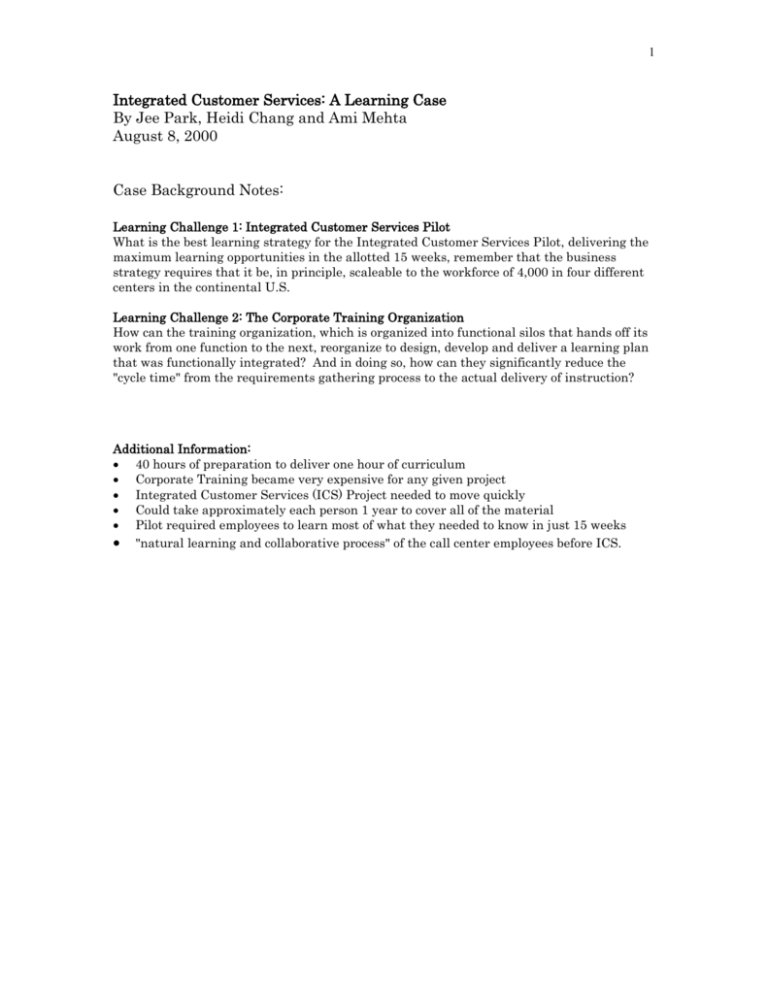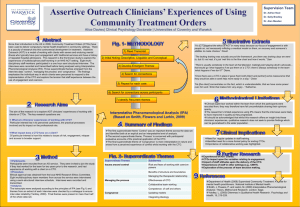Case Study - Learning, Design and Technology
advertisement

1 Integrated Customer Services: A Learning Case By Jee Park, Heidi Chang and Ami Mehta August 8, 2000 Case Background Notes: Learning Challenge 1: Integrated Customer Services Pilot What is the best learning strategy for the Integrated Customer Services Pilot, delivering the maximum learning opportunities in the allotted 15 weeks, remember that the business strategy requires that it be, in principle, scaleable to the workforce of 4,000 in four different centers in the continental U.S. Learning Challenge 2: The Corporate Training Organization How can the training organization, which is organized into functional silos that hands off its work from one function to the next, reorganize to design, develop and deliver a learning plan that was functionally integrated? And in doing so, how can they significantly reduce the "cycle time" from the requirements gathering process to the actual delivery of instruction? Additional Information: 40 hours of preparation to deliver one hour of curriculum Corporate Training became very expensive for any given project Integrated Customer Services (ICS) Project needed to move quickly Could take approximately each person 1 year to cover all of the material Pilot required employees to learn most of what they needed to know in just 15 weeks "natural learning and collaborative process" of the call center employees before ICS. 2 Learning Challenge 1: Integrated Customer Services Pilot The Learning Challenge The actual learning design plan and its implementation for the Integrated Customer Service pilot. Learning Design Goal Create a scaleable, 15-week learning strategy for a continental U.S. Integrated Customer Services Pilot. Key Assumptions 1. The pilot should be reflective of the same characteristics as the larger workforce. Consistency must be ensured across three key aspects of the learning environment. individual learners (learning style, levels of expertise, demographics,…) the instructors (level of knowledge about the topic, teaching style, and technology knowledge) the environment (classroom structure, computer systems, number of people in the class) 2. The first 50 employees in the pilot should: have previous training on customer service principles be self-selected to participate in the pilot have familiarity with technology be able to attend the entire 15 week course (no scheduled vacation) 3. The instructors are considered experts in this field. The number of instructors available will take into account their cost, but will also be an appropriate number for a small instructor to employee ratio. 4. The pilot will be conducted initially in English only. 5. The training in the Pilot Program will occur either in the morning or in the afternoon, allowing for participants to work at least half of the day. 6. Training will occur within the workday, not as an addition to the normal day. 7. Employees will remain specialists in one particular area of CS, but will learn how to access information to solve problems in other areas of CS. In order to meet these goals, the pilot and the larger learning strategy will consist of a collaborative, PBL-based, hybrid solution. The training will include both computer-based training and instructor led training. Purposes and benefits of the computer-based training: 1. Assess baseline knowledge of employees in order to create effective classes for instructor-led portion of training. 3 2. Teach employees “hard” skills, such as navigating through software applications and accessing information in databases. 3. Follow up assessment and periodic remediation will be provided through CBT. 4. Allows employees to learn at their own pace. 5. Updates and changes to the program can be made easily available to all employees. All baseline knowledge will be assessed through a computer-based program. From the results of this initial assessment, the group of 50 will be divided into two groups, based upon existing domain knowledge. These groups will be more homogeneous in nature in order to make the instructor led training more directed. Complex topics, as well as “soft” skills will be taught with an instructor, as she/he will be an expert in such areas. In the instructor led portion of the training, authentic problems will be at the center of the curriculum. The problems addressed in the curriculum will come from the participants themselves. Problem-based learning will be employed for several reasons. First, the nature of the pedagogy models the desired employee behavior. PBL focuses on the problem-solving process, not only the solution; the point of the training is to teach employees how to get better at solving problems. Therefore, the curriculum should focus on this process, not only the eventual outcome. Second, PBL involves the use of authentic problems, which will ground the training in real application, as well as provide motivation to learn how to solve the problems. Moreover, employees will draw from their own experiences on the job to create the problems that they will solve collaboratively during the training session. Employee involvement in this way will foster ownership of the training and reinforce the validity of the problems. Additionally, employees may also develop a sense of camaraderie upon discovery that their problems are not unique The training will focus on solving the problems that have been gathered by the aforementioned brainstorming session. Employees will then be divided into smaller groups of four in order to solve each problem. The groups should be mixed, so that the different specialties of the CS team will be represented. Groups will share their methods and answers with the rest of the group. This collaborative, team activity will encourage sharing of information and knowledge from different domains; employees will teach and learn from other employees. Another element of the training will involve role-playing and observation. Two instructors will enact a help call, which should come from the problems generated by the employee group. The other instructors and the employees 4 will observe the interaction and then break up into small groups to discuss the possible solutions to the call. The small groups will reassemble and share their ideas. The instructors will then recommend their solutions. This will be beneficial in training for several reasons. First, the employees will learn how to address problems that arise in help calls by observing and listening. They will gain an understanding of how an “expert” would solve the problem, which will help them develop a mental model for problem solving. Vygotsky suggested that novices need the guidance of experts in order to expand their understanding. Part of the training program will include “homework”. When employees return to their desks after their morning or afternoon training session, they will be asked to observe and listen to a co-worker in their vicinity. They will note both a problem that was solved by this employee and another that was not solved. They will share their observations in the next training session and discuss the successful strategies employed in solving the customer’s problem and also brainstorm ways that the unsolved problem could have been resolved by the customer service agent. Through these collaborative activities, employees will become familiar with their co-workers’ the strengths and domain knowledge. They will build relationships and a professional network from which they can draw upon when they have face a customer service call that they are not able to handle alone. Through this process, employees will also gain a sense of empowerment in their work, which may motivate them to have greater impact in their existing roles and ones they choose to take on once the training is complete. In order to reinforce the informal teams that were created during the training and to encourage continued informal learning after the 15-week training session, the physical layout of the office spaces should also be changed in order to promote collaboration among employees. A group of four employees, each with a different area of expertise should share the same space. In summary, there are many advantages to this hybrid solution. 1. Cost effective: The company is looking for a cost-saving model and the combination of instructor based training with computer-based training is more economical. Costs for instructor-based training are exponentially higher than costs for computer based training because the instructor needs to be paid 2. Ownership of the training: Employees are the true teachers in this training program. The problems they will learn from and the information they learn will come from their own experiences and 5 3. 4. 5. 6. observations. The training organization functions as a facilitator and organizer of information, not the source. Establish a community of learners: The practice of collaboration, sharing, and continued learning will be established and continued after the formal training has been completed. Personalized: The employees have the opportunity to be trained on a one-to-one basis as well as from an expert teacher. This addresses his or her personal learning style. Ease of use and assessment: The computer-based part of the program can be taught in modules and address any questions the employee might have even after the 15 week pilot session. Updates and changes to the process can also be communicated via the employee's computer. Sense of purpose: In competing this training program, employees will have both the cognitive and process tools to enable them to work with greater purpose because they will understand their roles as well as the “bigger picture”. The sense of empowerment they may feel is a direct result in the shift in the perception of the roles that they have of themselves and their co-workers. Their motivation to contribute may be improved as a by-product of their participation in this program. Disadvantages to the Hybrid Model As it stands, there is no allotted time in the work day for the CBT portion of the program. Employees would be required to complete the CBT on their own time, which may be met with some resentment. This may affect the quality of their experience with CBT. Furthermore, the current assessment available in CBT form is not very robust and may not accurately assess the employees’ understanding. Another possible problem with this model is that the curriculum depends upon the input of the participants. Taking into account the original assumption that participants are self-selecting and motivated, this problem may not be a huge issue. 6 Learning Challenge 2: The Corporate Training Organization The Learning Challenge The Corporate Training Organization and how they must change in order to meet the needs of the Integrated Customer Service Initiative. Currently the organization is set up in functional silos where "the right hand doesn't know what the left hand is doing". Functional Silos: Requirements Gathering Analysis of various tasks that employees perform Determine training needs of the workplace Hand- off to Design organization to write training design plan Curriculum Design and Development Curriculum writer takes the design document and develops specific curriculum Writes lesson on how to use various computer systems, how to understand the work process, how to interact w/ customers, how to understand the electronic documents Hand-off to Delivery organization in one day meeting Delivery of Training to Employees Process by which the instructors teach the curriculum to the employees to be trained Involves a corporate classroom setting, stand up instruction and computer terminals accessing company systems Learning Design Goal To design, develop and deliver an integrated learning plan, which, in turn, breaks down the functional silos. Also significantly reduce the "cycle time" from one function to the next. Assumptions 1. The functional silos are willing to work together to become more integrated. 2. Upper level management is clear on the need to work crossfunctionally. 3. The funding model supports a more cohesive organization, which is trying to deliver on a "one face to the customer, one-stop shopping operation." Design of the Corporate Training Organization The training program is highly dependent upon the acquisition of problems to be placed in the PBL curriculum. Therefore, it is recommend that the CTO abandon the functional silos and focus their attention collaboratively in two areas. 1. Acquisition of real-world problems from employees. Authentic problems are the center of PBL and it is essential that these problems reflect those that are common as well as valid to many CS agents. 7 2. Development of a general strategy for delivery of curriculum. The CTO should develop a template in order to present the problems. A template would allow every member of the CTO to take the real-world problems suggested by the CS agents and create a lesson around it. An example template could include a statement of the problem, the background information, and the action taken in the problem. In order to use the problem for learning purposes, a set of standard questions could be developed that would provide scaffolding for the CS agents while they are solving problems in their small groups. These questions could direct their thinking to address ideas about different perspectives, consider advantages and disadvantages of their solutions, and assess the knowledge and information needed in order to solve the problem. This suggested strategy for the CTO is beneficial because it allows everyone in the CTO to be aware of the progress that is made with the project, simultaneously utilizes all members of the CTO and thus eliminates intermediate waiting periods that previously occurred, and allows all members of the CTO to participate in the delivery of the program. While the CTO’s role in the delivery of the program is minimal and peripheral in nature, they will be present to ensure that people are on task and understand the activity in addition to maintaining the flow of progress during the training session. They do not necessarily have to be experts because they will be able to access the information from one of the other members of the CTO who will have the information. Therefore, the CTO will also be modeling the collaborative behavior that is desired from the CS agents. Summary of Benefits 1. Linear and silo-nature of the CTO is abandoned. One cohesive group is established. 2. The duties of the CTO are limited to basically two major areas that can be accomplished by the entire group. 3. Members of the CTO will learn from each other, which will model the collaborative behavior desired from the CS agents they are training. 4. CS agents will have more support in the classroom since more CTO members can facilitate the smaller learning group. Possible Disadvantages to the CTO Plan The members of the CTO may not be in the practice of working with members outside of their own area. They will have to gain a baseline understanding of the work of the other functional groups in order to be effective members of the entire group. There must be some common vocabulary and knowledge 8 shared by all members of the CTO before they can work effectively. This may take some time to establish. Also, members of the CTO who are not experienced in facilitating a classroom may need some training in this area. This may take some time, but those in need may learn from the members of the CTO who are experts in this field.








